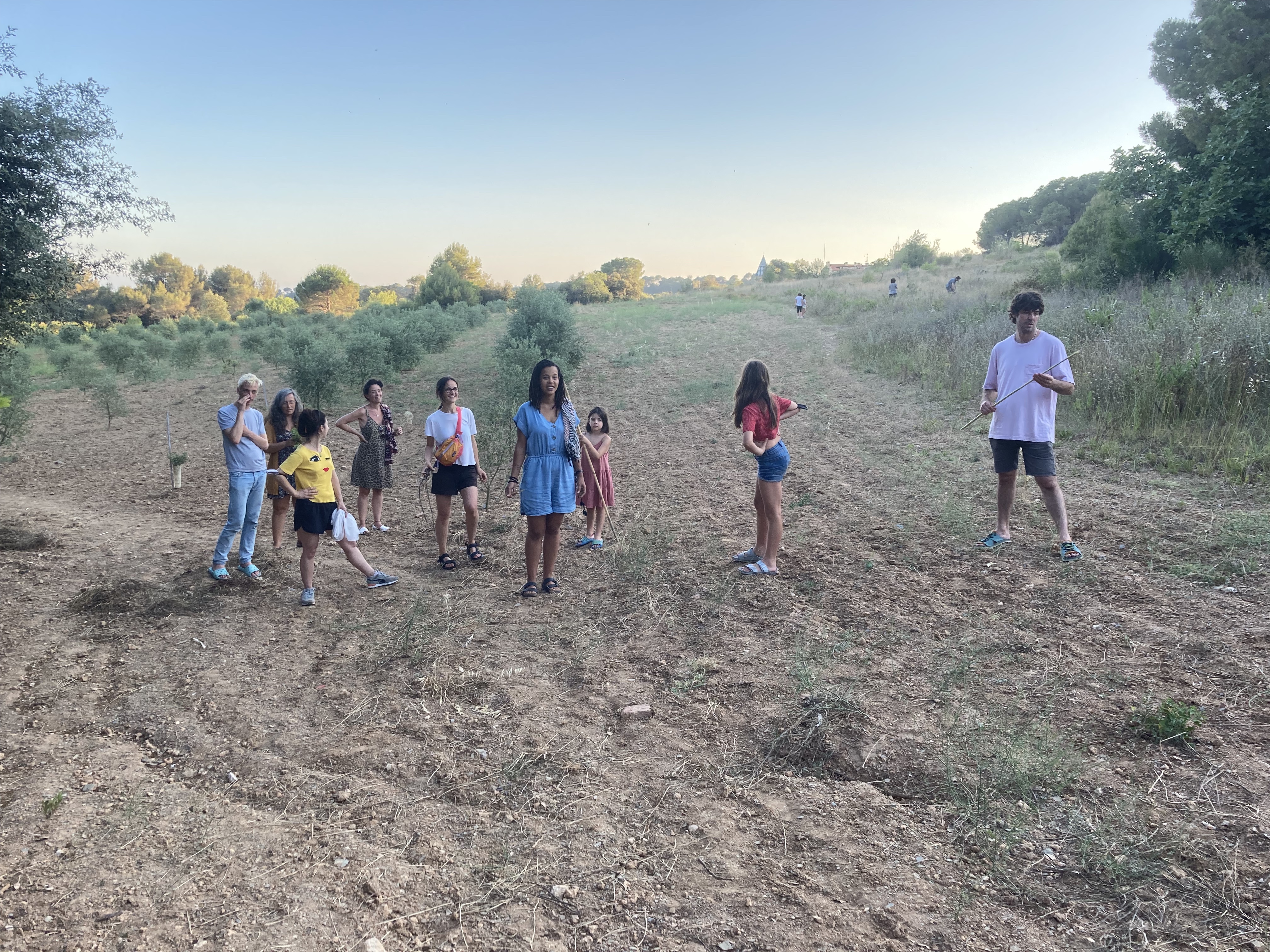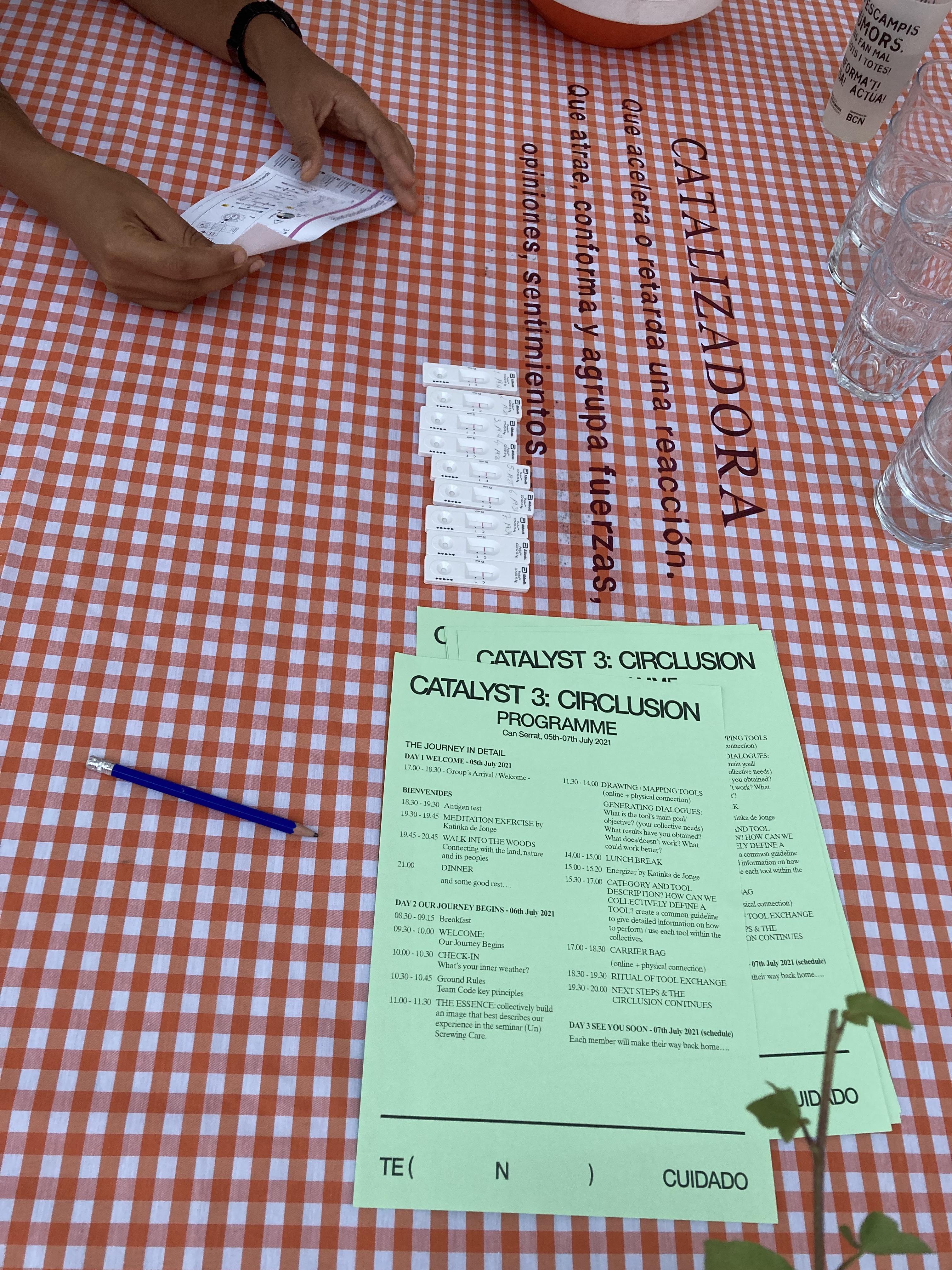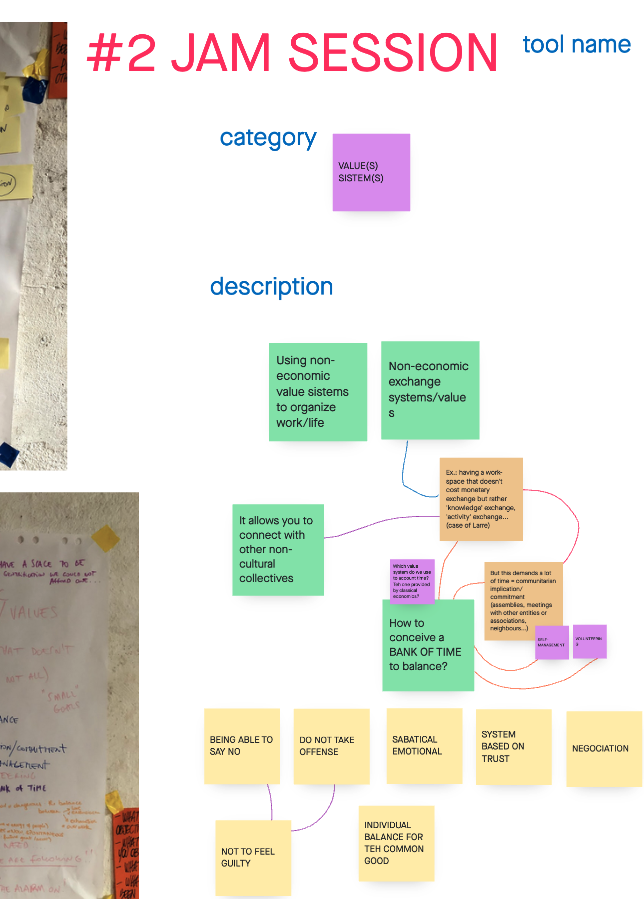CIRCLUSION
meetup and exchange around care based practice
meetup and exchange around care based practice
Presented at
︎ Antwerp University
︎ Can Serrat
Collaboration with
︎ Lara Garcia Diaz
︎ Larre
︎ Plata
︎ Conciencia Afro
︎ The Post Collective
︎ Volksroom
︎ K.A.K.
︎ Antwerp University
︎ Can Serrat
Collaboration with
︎ Lara Garcia Diaz
︎ Larre
︎ Plata
︎ Conciencia Afro
︎ The Post Collective
︎ Volksroom
︎ K.A.K.
“How can we build a community that circludes?
a community that cares
that serves
that hosts
and disseminates
at the same time
How can we shape our carrier bag?
And our care bag?
How not to penetrate but to circlude the practices of others?
(on language and care)
(on care and violence)
(on the concept of circlusion, again)”
These lines, written and read out loud by artist Katinka de Jonge for a collective ‘meditation’ exercise, were the starting point of the meeting where the 2nd Phase of ‘Catalizadora‘ 3 CIRCLUSION has been developed.

CIRCLUSION
Exchange and meetup, ungoing
2021 - [...]
![]()
Exchange and meetup, ungoing
2021 - [...]

What is the role of care in cultural organisations and in artistic practice?
Do we want cultural institutions and artistic practices to operate from the standpoint of care? What exactly does this mean?
How is care made tangible in artistic and cultural practices and organisations?
The aim of the Catalizadora CIRCLUSION is the exchange, co-creation and use of tools and/or specific methodologies that may lead us to question what are the practical consequences of operating from the standpoint of care.
This third Catalizadora is being carried out in intimate collaboration with artistic and cultural collectives Plata, Conciencia Afro and Larre, coming from Spain, and KAK, Volksroom and PostCollective coming from Belgium –learn more about them in the section Partners. These collectives are the catalyst agents invited to discuss, share, re-create and/or re-articulate ‘tools’ with which to foster and implement care in a practical way within their cultural and/or artistic organisations.
‘CIRCLUSION’ develops in three initial phases, proposing to test the normative codes and ways of doing of the ambits that host them – academic, artistic, civil society – as far as care is concerned:
Phase 1: (Un)Screwing Care SEMINAR
Organised in June 2021 in the framework of the academic Research Seminars Program at the Antwerp Doctoral School, with the support of Antwerp Research Institute for the Arts (ARIA) and the University of Antwerp (UA).
Phase 2: Circlusion MEETING
It was organised during 5, 6 and 7 July 2021 at the centre for artists’ residencies and cultural production Can Serrat (El Bruc, Catalonia).
Phase 3: CIRCLUDING Circlusion
Its development is scheduled for October 2021,
establishing a dialogue with citizens and social movements surrounding and supporting each of the invited groups.
Text by Larre
https://tencuidado.org/en/








Text by Larre
In order to generate and define 6 tools, Larre collective – promotor of the project Te( n ) cuidado – worked together with systemic facilitator Juliana Simoes and Belgian artist Katinka de Jonge. This collaboration allowed for dynamics and moments of exchange, co-creation and calm to be devised, conforming the CIRCLUSION Meeting, developed both face-to-face and partially online.
How can we collectively define a tool?
What is its use?
What is its goal?
What has worked?
What has not worked?
These were pivotal initial questions to be able to collectively define a series of portable, replicable and malleable tools in relation to care, based on experiences and visions shared by the individuals representing the invited collectives.
By means of an intense and intimate process of exchange, filtering, negotiation and collective re-articulation through the dynamics suggested, and with the support and facilitation of Juliana in this session, six tools were defined that are currently being used by the participating collectives. In turn, these tools are re-defined based on right or wrong outcomes in their implementation:
1. THE CARRIERS
> Category: Observation
> Description: Operating with non-anthropocentric perspectives and relations. First observing, then acting. Every seed contains information and strategies of its journey.
2. JAM SESSION
> Category: Value(s) system(s)
> Description: Use of different value systems in the organisation of a collective or a cultural practice. For instance, articulation of systems of exchange beyond capitalist value system based on exchange of capital.
3. FUCK FEAR
> Category: Crash, Boom, Bang
> Description: Connecting through error, mistake, failure. Letting unsafe constructions navigate us. Being vulnerable. Working on the unknown. Possibility for generating dialogue about plural forms of exclusion. Rejecting binarism.
4. RE-ROOTING
> Category: Wellness and balance
> Description: Building community based on the relationship with our ancestors, with ‘my’ self, the earth and the environment, and with other beings. Creating an encouraging environment to open possibilities – to choose a path or to develop full potential –, satisfying basic needs and priorities.
5. ASSERTIVE PRESENCE
> Category: Listening
> Description: Taking the time to listen to the stories of ‘others’. Listening without trying to fix things on behalf of or for ‘others’. Just listening! Even if we don’t understand what we hear… it’s simply about being there. Listening, transparency, intangible, radical, reciprocity, conscience, empathy, privilege, power relations.
6. CHECK-IN / CHECK-OUT
> Category: Maintenance
> Description: Making a round of consultations at the beginning and at the end of each meeting, assembly or gathering to get to know the status of all participants. Distribution of work or money by checking the practical/essential survival needs of members and participants. An individual need becomes a collective one. Fostering coexistence and redistribution. Collection, constellation, carrier bag…
What tools do we want to collect and carry in our bag or sack?
What conditions do we need so that this constellation can be maintained?
As closure for Phase 2: CIRCLUSION Meeting, each representative of the invited collectives chose one, two, three or as many tools as they wanted to use, creating their own ‘carrier bag’ and taking it with them together with the chosen tools. The mission was to implement them within the structure, dynamics and practices of their collective, and in their socio-political context and closest community.
In order to generate and define 6 tools, Larre collective – promotor of the project Te( n ) cuidado – worked together with systemic facilitator Juliana Simoes and Belgian artist Katinka de Jonge. This collaboration allowed for dynamics and moments of exchange, co-creation and calm to be devised, conforming the CIRCLUSION Meeting, developed both face-to-face and partially online.
How can we collectively define a tool?
What is its use?
What is its goal?
What has worked?
What has not worked?
These were pivotal initial questions to be able to collectively define a series of portable, replicable and malleable tools in relation to care, based on experiences and visions shared by the individuals representing the invited collectives.
By means of an intense and intimate process of exchange, filtering, negotiation and collective re-articulation through the dynamics suggested, and with the support and facilitation of Juliana in this session, six tools were defined that are currently being used by the participating collectives. In turn, these tools are re-defined based on right or wrong outcomes in their implementation:
1. THE CARRIERS
> Category: Observation
> Description: Operating with non-anthropocentric perspectives and relations. First observing, then acting. Every seed contains information and strategies of its journey.
2. JAM SESSION
> Category: Value(s) system(s)
> Description: Use of different value systems in the organisation of a collective or a cultural practice. For instance, articulation of systems of exchange beyond capitalist value system based on exchange of capital.
3. FUCK FEAR
> Category: Crash, Boom, Bang
> Description: Connecting through error, mistake, failure. Letting unsafe constructions navigate us. Being vulnerable. Working on the unknown. Possibility for generating dialogue about plural forms of exclusion. Rejecting binarism.
4. RE-ROOTING
> Category: Wellness and balance
> Description: Building community based on the relationship with our ancestors, with ‘my’ self, the earth and the environment, and with other beings. Creating an encouraging environment to open possibilities – to choose a path or to develop full potential –, satisfying basic needs and priorities.
5. ASSERTIVE PRESENCE
> Category: Listening
> Description: Taking the time to listen to the stories of ‘others’. Listening without trying to fix things on behalf of or for ‘others’. Just listening! Even if we don’t understand what we hear… it’s simply about being there. Listening, transparency, intangible, radical, reciprocity, conscience, empathy, privilege, power relations.
6. CHECK-IN / CHECK-OUT
> Category: Maintenance
> Description: Making a round of consultations at the beginning and at the end of each meeting, assembly or gathering to get to know the status of all participants. Distribution of work or money by checking the practical/essential survival needs of members and participants. An individual need becomes a collective one. Fostering coexistence and redistribution. Collection, constellation, carrier bag…
What tools do we want to collect and carry in our bag or sack?
What conditions do we need so that this constellation can be maintained?
As closure for Phase 2: CIRCLUSION Meeting, each representative of the invited collectives chose one, two, three or as many tools as they wanted to use, creating their own ‘carrier bag’ and taking it with them together with the chosen tools. The mission was to implement them within the structure, dynamics and practices of their collective, and in their socio-political context and closest community.